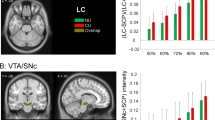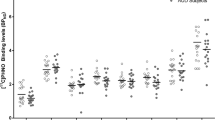Abstract
Dopamine signaling in nucleus accumbens is essential for cocaine reward. Interestingly, imaging studies have reported blunted dopamine increases in striatum (assessed as reduced binding of [11C]raclopride to D2/D3 receptors) in detoxified cocaine abusers. Here, we evaluate whether the blunted dopamine response reflected the effects of detoxification and the lack of cocaine-cues during stimulant exposure. For this purpose we studied 62 participants (43 non-detoxified cocaine abusers and 19 controls) using positron emission tomography and [11C]raclopride (radioligand sensitive to endogenous dopamine) to measure dopamine increases induced by intravenous methylphenidate and in 24 of the cocaine abusers, we also compared dopamine increases when methylphenidate was administered concomitantly with a cocaine cue-video versus a neutral-video. In controls, methylphenidate increased dopamine in dorsal (effect size 1.4; P<0.001) and ventral striatum (location of accumbens) (effect size 0.89; P<0.001), but in cocaine abusers methylphenidate’s effects did not differ from placebo and were similar whether cocaine-cues were present or not. In cocaine abusers despite the markedly attenuated dopaminergic effects, the methylphenidate-induced changes in ventral striatum were associated with intense drug craving. Our findings are consistent with markedly reduced signaling through D2 receptors during intoxication in active cocaine abusers regardless of cues exposure, which might contribute to compulsive drug use.
This is a preview of subscription content, access via your institution
Access options
Subscribe to this journal
Receive 12 print issues and online access
$259.00 per year
only $21.58 per issue
Buy this article
- Purchase on Springer Link
- Instant access to full article PDF
Prices may be subject to local taxes which are calculated during checkout



Similar content being viewed by others
References
Di Chiara G, Imperato A . Drugs abused by humans preferentially increase synaptic dopamine concentrations in the mesolimbic system of freely moving rats. Proc Natl Acad Sci USA 1988; 85: 5274–5278.
Koob GF, Bloom FE . Cellular and molecular mechanisms of drug dependence. Science 1988; 242: 715–723.
Wise RA, Rompre PP . Brain dopamine and reward. Annu Rev Psychol 1989; 40: 191–225.
Drevets WC, Gautier C, Price JC, Kupfer DJ, Kinahan PE, Grace AA et al. Amphetamine-induced dopamine release in human ventral striatum correlates with euphoria. Biol Psychiatry 2001; 49: 81–96.
Laruelle M, Abi-Dargham A, van Dyck CH, Rosenblatt W, Zea-Ponce Y, Zoghbi SS et al. SPECT imaging of striatal dopamine release after amphetamine challenge. J Nucl Med 1995; 36: 1182–1190.
Volkow ND, Wang GJ, Fowler JS, Logan J, Gatley SJ, Wong C et al. Reinforcing effects of psychostimulants in humans are associated with increases in brain dopamine and occupancy of D(2) receptors. J Pharmacol Exp Ther 1999; 291: 409–415.
Martinez D, Narendran R, Foltin RW, Slifstein M, Hwang DR, Broft A et al. Amphetamine-induced dopamine release: markedly blunted in cocaine dependence and predictive of the choice to self-administer cocaine. Am J Psychiatry 2007; 164: 622–629.
Volkow ND, Wang GJ, Fowler JS, Logan J, Gatley SJ, Hitzemann R et al. Decreased striatal dopaminergic responsiveness in detoxified cocaine-dependent subjects. Nature 1997; 386: 830–833.
Schultz W, Dayan P, Montague PR . A neural substrate of prediction and reward. Science 1997; 275: 1593–1599.
Phillips PE, Stuber GD, Heien ML, Wightman RM, RM C . Subsecond dopamine release promotes cocaine seeking. Nature 2003; 422: 614–618.
Volkow ND, Wang GJ, Telang F, Fowler JS, Logan J, Childress AR et al. Cocaine cues and dopamine in dorsal striatum: mechanism of craving in cocaine addiction. J Neurosci Jun 14 2006; 26: 6583–6588.
Wong DF, Kuwabara H, Schretlen DJ, Bonson KR, Zhou Y, Nandi A et al. Increased occupancy of dopamine receptors in human striatum during cue-elicited cocaine craving. Neuropsychopharmacology 2006; 31: 2716–2727.
Zhang Y, Schlussman SD, Rabkin J, Butelman ER, Ho A, Kreek MJ . Chronic escalating cocaine exposure, abstinence/withdrawal, and chronic re-exposure: effects on striatal dopamine and opioid systems in C57BL/6J mice. Neuropharmacology 2013; 67: 259–266.
Volkow ND, Wang GJ, Fowler JS, Logan J, Schlyer D, Hitzemann R et al. Imaging endogenous dopamine competition with [11C]raclopride in the human brain. Synapse 1994; 16: 255–262.
Volkow ND, Wang GJ, Fowler JS, Logan J, Franceschi D, Maynard L et al. Relationship between blockade of dopamine transporters by oral methylphenidate and the increases in extracellular dopamine: therapeutic implications. Synapse 2002; 43: 181–187.
Wang G-J, Volkow ND, Hitzemann RJ, Wong C, Angrist B, Burr G et al. Behavioral and cardiovascular effects of intravenous methylphenidate in normal subjects and cocaine abusers. Eur Addict Res 1997; 3: 49–54.
Tiffany ST, Singleton E, Haertzen CA, Henningfield JE . The development of a cocaine craving questionnaire. Drug Alcohol Depend 1993; 34: 19–28.
Volkow ND, Fowler JS, Wang GJ et al. Decreased dopamine D2 receptor availability is associated with reduced frontal metabolism in cocaine abusers. Synapse 1993; 14: 169–177.
Friston KJ, Holmes AP, Poline JB, Grasby PJ, Williams SC, Frackowiak RS et al. Analysis of fMRI time-series revisited. Neuroimage 1995; 2: 45–53.
Logan J, Fowler JS, Volkow ND, Wolf AP, Dewey SL, Schlyer DJ et al. Graphical analysis of reversible radioligand binding from time-activity measurements applied to [N-11C-methyl]-(-)-cocaine PET studies in human subjects. J Cereb Blood Flow Metab 1990; 10: 740–747.
Wang GJ, Smith L, Volkow ND, Telang F, Logan J, Tomasi D et al. Decreased dopamine activity predicts relapse in methamphetamine abusers. Mol Psychiatry 2011; 17: 918–925.
Volkow ND, Wang GJ, Ma Y, Fowler JS, Wong C, Ding YS et al. Activation of orbital and medial prefrontal cortex by methylphenidate in cocaine-addicted subjects but not in controls: relevance to addiction. J Neurosci 2005; 25: 3932–3939.
Cohen J . A power primer. Psychol Bull 1992; 112: 155–159.
Park K, Volkow ND, Pan Y, Du C . Chronic cocaine dampens dopamine signaling during cocaine intoxication and unbalances D1 over D2 receptor signaling. J Neurosci 2013; 33: 15827–15836.
Koya E, Golden SA, Harvey BK, Guez-Barber DH, Berkow A, Simmons DE et al. Targeted disruption of cocaine-activated nucleus accumbens neurons prevents context-specific sensitization. Nat Neurosci 2009; 12: 1069–1073.
Volkow ND, Wang GJ, Fowler JS, Logan J, Jayne M, Franceschi D et al. "Nonhedonic" food motivation in humans involves dopamine in the dorsal striatum and methylphenidate amplifies this effect. Synapse 2002; 44: 175–180.
Wakabayashi KT, Kiyatkin EA . Critical role of peripheral drug actions in experience-dependent changes in nucleus accumbens glutamate release induced by intravenous cocaine. J Neurochem 2013; 128: 672–685.
Wanat MJ, Kuhnen CM, Philips PE . Delays conferred by escalating costs modulate dopamine release to rewards but not their predictors. J Neurosci 2010; 30: 12020–12027.
Volkow ND, Wang GJ, Fowler JS, Tomasi D . Addiction circuitry in the human brain. Annu Rev Pharmacol Toxicol 2012; 52: 321–336.
Lee B, London ED, Poldrack RA, Farahi J, Nacca A, Monterosso JR et al. Striatal dopamine d2/d3 receptor availability is reduced in methamphetamine dependence and is linked to impulsivity. J Neurosci 2009; 29: 14734–14740.
Dalley JW, Fryer TD, Brichard L, Robinson ES, Theobald DE, Lääne K et al. Nucleus accumbens D2/3 receptors predict trait impulsivity and cocaine reinforcement. Science 2007; 315: 1267–1270.
Bock R, Shin JH, Kaplan AR, Dobi A, Markey E, Kramer PF et al. Strengthening the accumbal indirect pathway promotes resilience to compulsive cocaine use. Nat Neurosci 2013; 16: 632–638.
Thanos PK, Michaelides M, Umegaki H, Volkow ND . D2R DNA transfer into the nucleus accumbens attenuates cocaine self-administration in rats. Synapse 2008; 62: 481–486.
Volkow ND, Wang GJ, Fowler JS, Logan J, Gatley SJ, Gifford A et al. Prediction of reinforcing responses to psychostimulants in humans by brain dopamine D2 receptor levels. Am J Psychiatry 1999; 156: 1440–1443.
Volkow ND, Wang GJ, Fowler JS, Thanos PP, Logan J, Gatley SJ et al. Brain DA D2 receptors predict reinforcing effects of stimulants in humans: replication study. Synapse 2002; 46: 79–82.
Martinez D, Carpenter KM, Liu F, Slifstein M, Broft A, Friedman AC et al. Imaging dopamine transmission in cocaine dependence: link between neurochemistry and response to treatment. Am J Psychiatry 2011; 168: 634–641.
Wang GJ, Smith L, Volkow ND, Telang F, Logan J, Tomasi D et al. Decreased dopamine activity predicts relapse in methamphetamine abusers. Mol Psychiatry 2012; 17: 918–925.
Norman AB, Tabet MR, Norman MK, Fey BK, Tsibulsky VL, Millard RW . The affinity of D2-like dopamine receptor antagonists determines the time to maximal effect on cocaine self-administration. J Pharmacol Exp Ther 2011; 338: 724–728.
Caine SB, Negus SS, Mello NK, Patel S, Bristow L, Kulagowski J et al. Role of dopamine D2-like receptors in cocaine self-administration: studies with D2 receptor mutant mice and novel D2 receptor antagonists. J Neurosci 2002; 22: 2977–2988.
Durieux PF, Bearzatto B, Guiducci S, Buch T, Waisman A, Zoli M et al. D2R striatopallidal neurons inhibit both locomotor and drug reward processes. Nat Neurosci 2009; 12: 393–395.
Caine SB, Thomsen M, Gabriel KI, Berkowitz JS, Gold LH, Koob GF et al. Lack of self-administration of cocaine in dopamine D1 receptor knock-out mice. J Neurosci 2007; 27: 13140–13150.
Wee S, Koob GF . The role of the dynorphin-kappa opioid system in the reinforcing effects of drugs of abuse. Psychopharmacology (Berl) 2010; 210: 121–135.
Fuchs RA, Evans KA, Parker MP, See RE . Differential involvement of orbitofrontal cortex subregions in conditioned cue-induced and cocaine-primed reinstatement of cocaine seeking in rats. J Neurosci 2004; 24: 6600–6610.
Volkow ND, Fowler JS, Wang GJ, Telang F, Logan J, Jayne M et al. Cognitive control of drug craving inhibits brain reward regions in cocaine abusers. Neuroimage 2010; 49: 2536–2543.
Staley JK, Mash DC . Adaptive increase in D3 dopamine receptors in the brain reward circuits of human cocaine fatalities. J Neurosci 1996; 16: 6100–6106.
Le Foll B, Frances H, Diaz J, Schwartz JC, Sokoloff P . Role of the dopamine D3 receptor in reactivity to cocaine-associated cues in mice. Eur J Neurosci 2002; 15: 2016–2026.
Volkow ND, Wang GJ, Tomasi D, Telang F, Fowler JS, Pradhan K et al. Methylphenidate attenuates limbic brain inhibition after cocaine-cues exposure in cocaine abusers. PLoS One 2010; 5: e11509.
Small AC, Kampman KM, Plebani J, De Jesus Quinn M, Peoples L, Lynch KG . Tolerance and sensitization to the effects of cocaine use in humans: a retrospective study of long-term cocaine users in Philadelphia. Subst Use Misuse 2009; 44: 1888–1898.
Acknowledgements
We thank Paul Vaska, Colleen Shea, Pauline Carter, Wei Zhu, Karen Apelskog and Ruben Baler for their contributions. Research supported by NIH’s Intramural Research Program (NIAAA).
Author information
Authors and Affiliations
Corresponding author
Rights and permissions
About this article
Cite this article
Volkow, N., Tomasi, D., Wang, GJ. et al. Stimulant-induced dopamine increases are markedly blunted in active cocaine abusers. Mol Psychiatry 19, 1037–1043 (2014). https://doi.org/10.1038/mp.2014.58
Received:
Revised:
Accepted:
Published:
Issue Date:
DOI: https://doi.org/10.1038/mp.2014.58
This article is cited by
-
Neural circuit selective for fast but not slow dopamine increases in drug reward
Nature Communications (2023)
-
Amphetamine-induced prolonged disturbances in tissue levels of dopamine and serotonin in the rat brain
Pharmacological Reports (2023)
-
Repeated chemogenetic activation of dopaminergic neurons induces reversible changes in baseline and amphetamine-induced behaviors
Psychopharmacology (2023)
-
Sex differences in methylphenidate-induced dopamine increases in ventral striatum
Molecular Psychiatry (2022)
-
Involvement of the ghrelin system in the maintenance of oxycodone self-administration: converging evidence from endocrine, pharmacologic and transgenic approaches
Molecular Psychiatry (2022)



